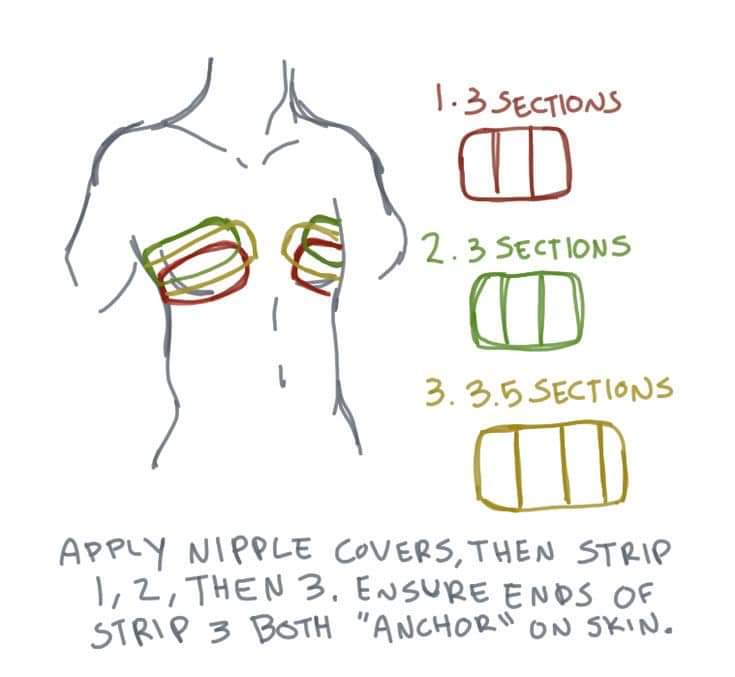
Trans Tape
(also: elastic theraputic tape, kinesiology tape, Kinesio tape, k-tape, kt tape)

Table of Contents

Introduction
Having visible breasts is generally considered an indication that the person attatched to them is female. For transgender men, as well as many transmasculine nonbinary people, this visible indicator is a massive source of gender dysphoria. While binding using a garment known as a binder is a more common method of binding one's breasts, some people prefer to use body-safe tape commonly known as "trans tape."
Some transgender people who bind, either using a binder or trans tape, get top surgery later on as a part of their gender transitions. Others, particularly nonbinary people, may prefer simply to bind whenever they feel like it. Some nonbinary, such as those who identify as genderfluid, only sometimes experience gender dysphoria, and do not have a constant need to bind their breasts.

General Information
Trans tape is a body-safe tape that is sometimes used for transmasculine individuals to bind their breasts to promote gender euphoria. Trans tape is very similar to other body-safe tapes, such as kinesiology tape (also referred to as KT tape), that are used by athletes. Some transgender men simply us KT tape in place of branded trans tape.
Trans tape is often more effective for individuals with smaller breasts, though plenty of guys with larger ones have found success. Trans tape can stay on your body for several days at a time, and can be worn safely during exercise, unlike binders, which need regular breaks for those who wear them.
Binding using trans tape is not recommended for those with sensitive skin.

How To Use
Before applying tape to your body, make sure that your skin is clean and dry.
To protect your nipples, fold a piece of tape so that the sticky side is not facing your nipples, and tape it over them. You can also use a piece of tissue, or whatever else you have handy to protect your nipples. You do not want to have to remove tape from that area.
One breast at a time, place tape to cover the breast and gently pull it to the side (away from the center of your chest) and secure it. With a bigger chest, you may need to use more tape. At the bottom of the page, see the videos if you would like more of a visual demonstration.
When it comes time to remove the tape, you must soak it completely in oil (cooking oil or something similar will work). Do not rush to remove the tape. If you are not careful, you can rip off your skin, causing damage. Blisters are not uncommon with improper removal. Breast tissue can be delicate, and it will be painful. You will not be able to bind until your skin heals. So long as you are careful, however, you should be fine.
If you have sensitive skin, it may be a good idea to use a small piece of tape at first to see how you react to the adhesive. You do not want to put on a large quantity of tape and experience an allergic reaction.

Diagram of Trans Tape Application


External Links
The inclusion of these links is not an endorsement. These links are not sponsored. These links are provided as examples of the topic being discussed and further research and reading material for those who seek it.

Buy Tape

Based in Australia
- sock drawer heroes (https://sockdrawerheroes.com/)
- Tuck & Bind (https://tuckandbind.com/)
- ur basics (https://urbasics.ca/)

Based in Canada

Based in China

Based in New Zealand
- bind me (https://www.bindme.co.nz/)
- desertcart (https://www.desertcart.nz/products/504824221-trans-gen-x-trans-gen-x-2-pack-4-inch-wide-ftm-trans-chest-tape-the-best-trans-binding-tape)

Based in The Netherlands

Based in The United States
- kt tape (https://www.kttape.com/)
- trans tape (https://transtape.life/) - Maine
- wivov (https://wivov.com/) - ships from US, UK, or Hong Kong

Additional Resources
- Banabuddy: Trans Tape: A Comprehensive Guide For FTM
- Emisil: Binding with Trans Tape FTM - A Complete Guide
- gendergp: 08/28/2024: how to use tape
- healthline: Gregory Minnis, DPT & Rebecca Joy Stanborough, MFA: 04/20/2019: kinesiology tape
- Off Binary: Charlie Lewis: July 2023: Trans Tape and Other Binding Tapes: The Ultimate Guide
- Queering Medicine: Chest Binding: Recommendations for Binding or Taping Your Chest Safely
- Strouse: Lee K. House: 02/11/2025: The 7 Best Stick to Skin Tapes
- Wikipedia - Elastic Theraputic Tape (https://en.wikipedia.org/wiki/Elastic_therapeutic_tape)
- YouTube Video: TransTape: 06/04/2023: Everyone Meet Beau DuBois! | Large Chest Tips
- YouTube Video: Rowan Wallace: 07/14/2019: How I put on my trans tape
- YouTube Video: Beau DuBois: 02/09/2020: Transtape application

